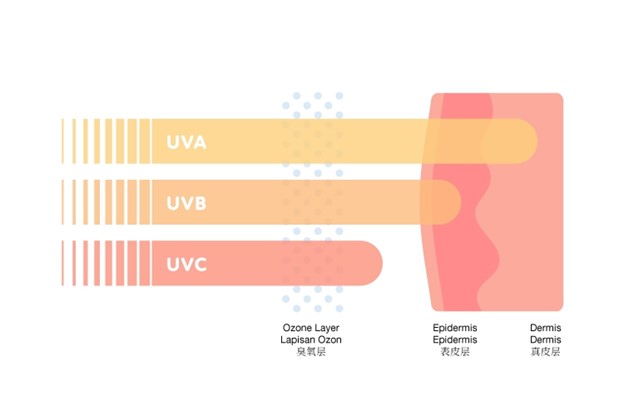There’s something that feels so good about getting outside and soaking up some fresh air —not to mention the vitamin D boost you can get from a little sun.
Whether you’re heading out for daily walks, hopping on a bike or heading for a beach vacation, it’s a good idea to brush up on Sunscreen 101. It can literally save your skin.
All skin needs protection from the sun’s harmful rays. It doesn’t matter if your skin tone is light, dark or in between. But not all sunscreen products are created equal and their labels can be confusing. Let’s go through some of the basics so you can pick the best products to include in your skincare routine.

UVA vs UVB: What’s the difference?
Ultraviolet (UV) radiation is part of the natural energy produced by the sun and there are 3 types of UV radiation: UVA, UVB and UVC rays. UVC rays are the most harmful of the three, but they are completely filtered by the atmosphere and doesn’t even reach Earth. That leaves us with UVA and UVB rays, and unfortunately, prolonged exposure to either of these UV rays is a major risk factor for sun-damaged skin.
What’s the difference between the two rays and the damage they can do to your skin? Ultraviolet B (UVB) rays are also known as burning rays. They penetrate and can damage the top layers of your skin so too much exposure to UVB rays cause sunburn and even blistering.
The intensity of UVB rays fluctuate throughout the day. You need more protection from them when the sun’s rays are the strongest, which is typically from late morning to mid-afternoon. These rays can also bounce off the metal surfaces of vehicles and other reflective surfaces, hitting your skin and causing twice the damage.
Meanwhile, Ultraviolet A (UVA) rays are known as ageing rays. They are more prevalent and absorb deeper into your skin, causing the pigment there to darken as well as increasing wrinkles and loss of elasticity. These rays can pass through the windows in your home or vehicle, and are present even on cloudy days.
Both of these rays harm the skin in different ways, so it’s important to protect your skin against both UVA and UVB rays – which is where a sunscreen with broad spectrum protection comes in.
What is broad spectrum protection?
Broad spectrum protection refers to a sunscreen that protects against UVA and UVB rays. If the label doesn’t indicate broad spectrum, this means the product only protects against UVB rays.
When selecting a sunscreen to apply all over your body – from the tops of your ears to the tips of your toes – it’s always better to pick a broad spectrum formula but don’t forget to look at the SPF too.
What does SPF stand for?
All sunscreens have SPF, or sun protection factor. In general, this number tells you how long it would take the sun’s UV rays to burn your skin when you are using the sunscreen, compared to how long it would take to burn your skin without any sunscreen.
For example, if you rub sunscreen with SPF 30 into your skin, it would take about 30 times longer for your skin to burn than if you were not wearing any sun protection. But the intensity of the sun exposure also matters because people can burn more quickly at different times of the day. Remember, UVB rays are intense between mid-morning and mid-afternoon so a stronger SPF will help protect your skin better. Therefore, the American Academy of Dermatology (AAD) recommends using, at minimum, a sunscreen with SPF 30 daily.
Is there really any difference between SPF 30 and SPF 50?
Once your SPF numbers get to 30 and above, there is a bit of a difference between them, but not a whole lot.
An SPF 15 sunscreen blocks 93% of UVB rays from the sun, while an SPF 30 blocks 97% and an SPF 50 blocks 98%. Nothing blocks 100% of the sun’s harmful rays, but every little bit helps.
Also important: Using a higher number does not mean you can stay in the sun longer. No matter what SPF level you’re using, sunscreen should be reapplied every two hours when you’re outside and more frequently if you’re swimming or sweating.

What type of sunscreen should I use for my face?
In our diverse country, everyone's skin has varying levels of pigmentation. But, regardless of your skin tone, all skin needs to be protected by sunscreen.
That means your morning skincare routine should include sunscreen.
Consider the Artistry Skin Nutrition Multi-Defense UV Protect SPF50+ which provides UVA/UVB protection. It includes protective antioxidants and ingredients to even your skin tone and helps treat dark spots and discoloration. You can also layer this SPF on top of your day creams for reapplication.
Here’s a quick table to summarize your morning skincare routine with your sunscreen:

* In vitro testing
** Ex vivo testing